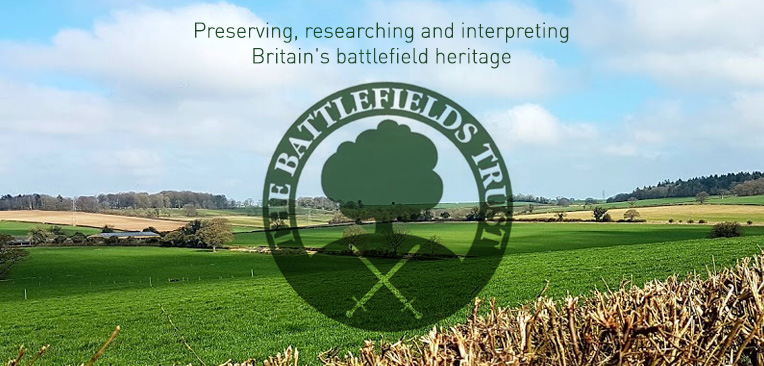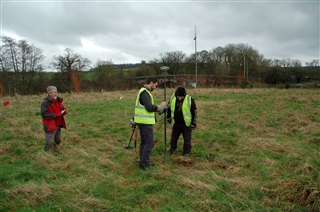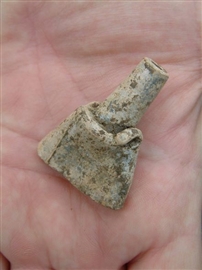News

Nibley Green (1470) Update
20 September 2014
Following its objections to the planned installation of a solar array on the Wars of the Roses battlefield at Nibley Green (see news item below dated 28 June 2014), the Battlefields Trust has raised concerns about the archaeological investigation of the site, which involves digging trenches across around two percent of the proposed development area. This does not conform to best practice battlefield archaeology and is unlikely to find the battlefield.
The Trust has raised these concerns with the planning archaeologist at Gloucestershire County Council who has informed the Trust that the work is not designed to find the battlefield, but rather Roman, Saxon and earlier remains. He also judges that any surviving battlefield archaeology in the top soil is unlikely to be damaged or moved a great distance given that the spoil from the trenches will be returned to the same trench after the investigation has taken place. In addition, the installation of the solar array only involves cable trenching and the driving of piles into the ground to fix the arrays, which again, he says, will have no impact on any battlefield remains.
In the Trust's view the failure to try and locate the battlefield is a missed opportunity and prevents a full heritage understanding of the site; one, if the battlefield can be found, that is likely to be significant because it involved only single retinues fighting which could provide a valuable archaeological signature for comparison with other battlefields of the period. But answering wider research questions does not seem to have a place in planning archaeology.
The National Planning Policy Framework, the government's guide to making planning decisions, says the benefit of development needs to be weighed against the harm to the heritage asset when making a planning decision and without a full understanding of the site, including whether the battlefield is there so that the terrain value can be considered, the Trust finds it difficult to understand how such a complete judgement can be made. The apparent lack of appreciation of the value of terrain, and by implication the wider battlefield setting, reflected in the archaeological advice provided by the Council seems to be based on a judgement that the overall importance and significance of the battle is low.
The options for the Trust at Nibley Green are now limited to making further appeals to the planing committee that will take the decision on development. Nevertheless, the Trust intends to raise the issues in this case and others with English Heritage to explore whether there would be value in developing practice guidance for planning and commercial archaeologists to assist the consideration of archaeological issues in planning applications and investigations on battlefield sites.
 Now available! A field guide to registered historic battlefields in England
Now available! A field guide to registered historic battlefields in England
18 November 2025
Read More
 Battlefields at risk - Historic England publishes its revised Heritage at Risk register
Battlefields at risk - Historic England publishes its revised Heritage at Risk register
6 November 2025
Read More
 Formal Launch of the Wars of the Roses Memorial Database
Formal Launch of the Wars of the Roses Memorial Database
15 October 2025
Read More
 Big Battlefield Walks Weekends prove successful despite the weather
Big Battlefield Walks Weekends prove successful despite the weather
23 September 2025
Read More
 HS2 damages nationally important battlefield
HS2 damages nationally important battlefield
18 September 2025
Read More
 Bosworth battlefield sculpture trail opened
Bosworth battlefield sculpture trail opened
18 September 2025
Read More
 Worcester's Civil War heritage brought to life with striking new banner installation
Worcester's Civil War heritage brought to life with striking new banner installation
16 August 2025
Read More
 Wars of the Roses Memorial Database Launched
Wars of the Roses Memorial Database Launched
29 March 2025
Read More
 Battlefields Trust Journal 2024 Published
Battlefields Trust Journal 2024 Published
19 March 2025
Read More
 Powick Old Bridge repairs progressing
Powick Old Bridge repairs progressing
18 March 2025
Read More
 Battlefields Trust enlists cross party MP support to engage government on battlefield protection
Battlefields Trust enlists cross party MP support to engage government on battlefield protection
20 January 2025
Read More
 New Civil War battlefield memorial and information board unveiled at Middleton Cheney
New Civil War battlefield memorial and information board unveiled at Middleton Cheney
6 June 2023
Read More
 Battlefields Trust Journal - Call for submissions
Battlefields Trust Journal - Call for submissions
20 October 2022
Read More










